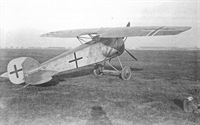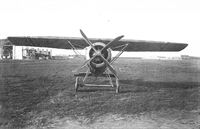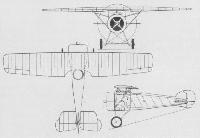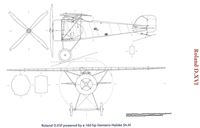
| Самолеты (сортировка по:) | |||||
| Страна | Конструктор | Название | Год | Фото | Текст |
LFG Roland D.XVI

|
Страна: Германия Год: 1918
Fighter |
| LFG Roland - D.XIII/D.XV - 1918 - Германия | <– | –> | LFG Roland - D.XVII - 1918 - Германия |
 |
J.Herris - Roland Aircraft of WWI /Centennial Perspective/ (9) |
| Roland D.XVI prototype powered by the 160 hp Siemens-Halske Sh.III |
 |
J.Herris - Roland Aircraft of WWI /Centennial Perspective/ (9) |
| Roland D.XVI prototype powered by the 160 hp Sh.III engine, which was in production. Undoubtedly inspired by the production Fokker E.V/D.VIII parasol monoplane, the Roland D.XVI did not surpass it. Little in the way of hard fact appears to have survived concerning the pair of parasol-winged LFG Roland D XVIs of mid-1918, other than that they were powered by the 160hp Siemens-Halske Sh III or 170hp Goebels rotaries. Both were entered for the third of the 1918 fighter trials, held in October. This is the first example, the second machine having a taller fin and rudder. |
 |
J.Herris - Roland Aircraft of WWI /Centennial Perspective/ (9) |
| The Roland D.XVI powered by the 160 hp Sh.III rotary |
 |
R.Kosin - The German Fighter since 1915 /Putnam/ |
| Second to last Roland fighter was the experimental Type D.XVI. (160 h.p. eleven-cylinder Siemens-Halske Sh III engine.) A Siemens-Halske Sh III engine distinguished the second of the two D XVI fighter prototypes. |
 |
J.Herris - Roland Aircraft of WWI /Centennial Perspective/ (9) |
| The Roland D.XVI powered by the 160 hp Sh.III rotary competed at the Third Fighter Competition as "an interesting type" despite not using the specified 185 hp BMW.IIIa engine. During most of 1917 Idflieg encouraged designers to try triplanes, but during 1918 monoplanes became increasingly popular for fighter designs due to their greater speed, and the last two Roland fighter designs to be built were monoplanes. |
 |
J.Herris - Roland Aircraft of WWI /Centennial Perspective/ (9) |
 |
J.Herris - Roland Aircraft of WWI /Centennial Perspective/ (9) |
| L.F.G. Roland D XVI (second version) powered by the experimental 160 hp Goebel Goe.III 11-cylinder rotary engine. |
 |
J.Herris - Roland Aircraft of WWI /Centennial Perspective/ (9) |
| L.F.G. Roland D XVI (second version) powered by the experimental 160 hp Goebel Goe.III 11-cylinder rotary engine. |
 |
W.Green, G.Swanborough - The Complete Book of Fighters |
| Second prototype of the D XVI fighter. |
 |
J.Herris - Roland Aircraft of WWI /Centennial Perspective/ (9) |
| Roland D.XVI powered by a 160 hp Siemens-Halske Sh.III |
 |
J.Herris - Roland Aircraft of WWI /Centennial Perspective/ (9) |
| Roland D.XVI powered by a 160 hp Goebel Goe.III |
 |
J.Herris - Roland Aircraft of WWI /Centennial Perspective/ (9) |
| Roland D.XVI |